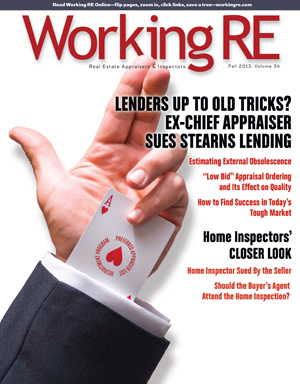 |
>> See Past News Editions >> Click to Print >> RE Agent / Broker E&O Insurance >> Am I a Working RE Subscriber? |
Editor’s Note: Many appraisers insist that despite appraisal reform, pressure to influence value remains. Compliance is still rewarded, they say, and stubborn independence is all too often punished. Here is a case in point that is gaining national attention.
Appraiser Pressure Alive and Well: Stearns Lending Sued by Ex-Chief Appraiser
by Isaac Peck, Associate Editor
A recent lawsuit (find link below) filed against Stearns Lending and its AMC, Trimavin, by the AMC’s former Chief Appraiser, Katherine A. Scheri, alleges that many of the practices that led to the extensive regulation of the appraisal industry are alive and well at one AMC/lender at least.
Appraiser Lists
In late 2011, Katherine Scheri was hired as the Chief Appraiser of Trimavin, an in-house AMC owned by Stearns Lending, a privately held lender who funded over $25 billion in loans over the last three years. Scheri has over 10 years of experience as a field appraiser, review appraiser, and appraisal manager. Prior to being appointed Chief Appraiser at Trimavin, Scheri worked as an appraiser manager overseeing a staff of nine certified appraisers and two trainees.
Among her responsibilities as Chief Appraiser, Scheri was charged with managing Trimavin’s active appraiser panel and overseeing the Appraisal Review Department. Upon assuming her position, Scheri implemented an internal process for appraisal reviews, and, the suit alleges, put an end to Trimavin’s practice of having reviews performed by appraisers who were not licensed in the state of the appraisal. Scheri also implemented a policy that only FHA certified appraisers could review FHA/USDA appraisals.
Acording to the suit, Scheri quickly learned that Stearns Lending had implemented a marketing program aimed at recruiting mortgage brokers and loan officers that promised them that their own personal lists of preferred appraisers would be added to Trimavin’s appraiser panel and would be used on the loans that they submitted. The result, according to the suit, was that private appraiser panels were created for each mortgage broker or loan officer at a given branch.
According to the suit, Scheri began pushing back against this practice and immediately began receiving emails and phone calls from loan officers, branch managers, and mortgage brokers complaining that their preferred appraisers were not being used on their loans and insisting that Stearns Lending had promised them that they could use their own appraisers. The suit alleges that Scheri notified the CEO of Trimavin, Eric Dellorusso, that it is in direct violation of the appraisal independence regulations of Dodd-Frank as well as Regulation Z of the Truth in Lending Act, for individuals in the loan production department to directly or indirectly select (or exclude) an appraiser for a particular appraisal.
(story continues below)
(story continues)
Not long after, a meeting was held with upper management from Stearns Lending and Trimavin to discuss Scheri’s concerns. According to the suit, upper management of both Trimavin and Stearns insisted that there is nothing wrong with loan officers providing lists of their preferred appraisers because those names are “blended” with the list of approved appraisers. Scheri responded that such selection is in violation of appraiser independence regulations and Regulation Z of TILA. Additionally, Scheri soon learned that the ranking of appraisers was done in such a way that the “preferred” appraisers were always utilized first, according to the suit. Despite her admonitions, the practice of using loan officer’s preferred appraisers continued.
According to Richard Hagar, SRA, an experienced litigation consultant and expert on appraiser independence regulations, if Scheri’s allegations are true, then Stearns Lending violated numerous federal regulations governing the appraisal process, including Regulation Z of the Truth in Lending Act. “The law is very clear on this point. There is no excuse for there being ANY kind of referrals or recommendations of appraisers from loan officers. Loan officers are sales people, they work in a completely separate function and they wouldn’t know a quality appraisal if it was staring them in the face. To most loan officers, good appraisers are the ones who meet value,” says Hagar.
Hagar says that even if an AMC’s appraisal panel is thin in some areas, that is no excuse for letting loan officers influence the selection of appraisers. “The law doesn’t say ‘no loan officer influence, except in those areas where your appraiser panel is thin.’ Loan officers should never recommend or communicate the names of any appraisers to the Chief Appraiser or to personnel managing the approved appraisal panel. To do so is a violation of appraiser independence regulations and should warrant a fine of $10,000 a day for as long as management was aware of the problem. What we’ve seen with some of the lenders and AMCs in the industry is, now that the system has been around for a couple of years, they are trying to figure out ways to manipulate and get around the law,” says Hagar. (For more, see Hagar’s upcoming live webinar on how to recognize and handle illegal influence: Top Five Questions Asked of an Appraiser and How to Answer.)
Builder Lists
Scheri’s suit alleges that during her tenure, Stearns Lending was conducting a joint venture with builder William Lyon Homes. The Vice President of the joint venture, Jason Forman, formulated a list of “approved” appraisers, according to the suit, and used only this customized list of appraisers on all appraisals performed for loans with William Lyon Homes. Lately, builders have been particularly vocal when it comes to appraiser issues, with the National Association of Home Builders (NAHB) publishing a white paper which calls for wide-scale appraisal reform because of “extreme bias…imbedded in the home valuation process.” Appraiser Tim Andersen discusses NAHB’s whitepaper in Working RE’s most recent News Edition: Home Builder’s Whitepaper: Appraisers are Idiots.
Remembering Countrywide
In May 2012, Brian Hale, former CEO of MetLife Bank, was hired as CEO of Stearns Lending. Before serving as the CEO of MetLife Bank, which was forced to exit the residential mortgage market during his tenure, Hale was the Chief Operations Officer at Countrywide Home Loans, which was later revealed as having one of the most toxic mortgage portfolios in the nation.
Shortly after Hale was hired at Stearns, Scheri alleges that she observed a printed list of the names, addresses, and telephone numbers of appraisers in Dellorusso’s office. When she asked what the list was, Scheri alleges that Dellorusso told her that he had been given a list of appraisers by Hale and that those were the appraisers that Trimavin would be using going forward. During this time, Trimavin had just finished purchasing a new Collateral Management System (CMS) from FNC as well as a select list of 8,500 appraisers rated with exceptional quality scores and vetted based on their qualifications, the suit alleges.
Instead of utilizing the list that Trimavin had, Scheri’s suit alleges that Dellorusso hired temporary workers to key in the printed appraiser list that Hale provided. Additionally, once the system was rolled out, Scheri observed that the list of 8,500 “qualified” appraisers was never imported into the CMS system and that the rating system within the CMS only utilized those appraisers who were on the list Hale provided.
Throughout her time as Chief Appraiser, Scheri alleges, she continued to receive threatening phone calls and emails from loan production personnel demanding that appraisers be added or removed from the approved appraiser panel. In some cases, they would request that a second appraisal be performed by “their” appraiser when they did not like the value opinion of the original appraiser. Scheri continued to respond that such actions were in violation of federal regulations and that she would not comply with such requests.
End of the Road
In December 2012, Scheri alleges that she was told by Dellorusso that he felt the stress of her job was affecting her and that she should consider transferring to a different position within the company. Furthermore, Dellorusso told her that he believed a man could handle the stress of the job as Chief Appraiser better than she could, according to the suit. Scheri responded that she wasn’t interested in moving to a different position as she had been hired to make sure Trimavin’s appraisal process was in accordance with applicable laws.
The next day, the suit alleges, Scheri was told that she was being insubordinate and that Dellorusso was going to make the decisions regarding the appraiser process and which appraisers would be placed on the panel. Once again, Scheri alleges, she made it clear that the actions Dellorusso was taking were illegal and that she was not willing to risk her license and would not go along with it.
(story continues below)
(story continues)
Within a few weeks, Scheri came across her job posted online. After confronting Dellorusso and taking the issue to the human resources and legal departments, she was terminated by Trimavin in January 2013 because, the suit alleges, management indicated it had “lost confidence in her ability to manage.” Scheri declined the severance package which included a confidentiality clause, and chose instead to sue Trimavin and Stearns Lending for unlawful retaliation and wrongful termination in violation of public policy.
Stearns Denies Any Wrongdoing
For its part, Stearns Lending denies the allegations laid out in the suit. Representing Stearns is attorney Greg S. Labate, Esq. Labate issued the following statement to Working RE: “TriMavin and Stearns Lending have thoroughly investigated the claims made by Ms. Scheri, a former employee of TriMavin, and have determined that her lawsuit has absolutely no merit whatsoever. TriMavin and Stearns Lending will vigorously defend themselves against Ms. Scheri’s false accusations, and they look forward to their day in court to disprove these frivolous and malicious allegations.”
Appraiser Independence
Scheri’s allegations echo what many appraisers have been saying all along; that lenders continue to manipulate the appraisal process by using carefully filtered lists of appraisers who don’t cause “trouble” and by “blacklisting” (or not using) appraisers who resist compliance.
Earlier this year, in an interview with Working RE, Kyle Lagow, the appraiser whistleblower at Countrywide Financial, said that even though his case helped lead to a $1 billion settlement between the Department of Justice and Bank of America, he doesn’t see that much has changed in the appraisal industry. “The same people who were in charge when this fraud took place are still here. My supervisor at Landsafe, the area manager, is still there. The appraiser who was completing 400 appraisals a month in Texas still has his license. So you tell me, what’s changed?” said Lagow.
Appraiser Thomas J. Inserra, MBA, MAI, SRA, who served as the National Chief Appraiser for the FDIC/RTC during the 1990s, reports that from what he’s seen across the industry of late there are still many lenders who are breaking the law and conducting business the way they did during the real estate boom. “There are still many hold-outs who continue to believe they can simply waive or ignore rules, laws or procedures that they just don’t like. In fact, some would argue that there is a new wave of ‘dumb’ lenders going back to the old practices,” says Inserra.
Conducting business like in the “good old days” means sidestepping the appraisal process with appraisers continuing to face challenges to their independence. “I have had recent conversations with CEOs and top executives of very large financial institutions who say they believe that to be competitive today and into the future, they must focus on comprehensive risk management. And they shake their heads in disbelief over what some lenders are doing today- a total repeat of the conduct that led to the crisis- manipulation and control of the appraiser process to the point of breaching independence and attaining advocacy,” says Inserra.
Editor’s Postscript: Full Circle
The “firewall” imposed between appraisers and lenders by the Home Valuation Code of Conduct (HVCC) ended direct business relationships between appraisers and their mortgage broker/lender clients. It resulted in a land-office business for a new crop of appraisal management companies (AMCs) and the demise of many small appraisal businesses. With this monumental shift came a significant pay cut for most residential real estate appraisers and a diminution in their ability to compete on quality and service and personal relationships.
With so many appraisers forced out of business in recent years, things have improved for those who remain. Fees are rising due to supply and demand. And the tables have turned a bit with appraisers better able to pick and choose which AMCs they will do business with rather than the other way around. Appraisers are negotiating higher fees and more reasonable turn times. With so much work, they can choose to work with the very best clients. But even in these “better days,” many insist that the pressure to influence value still exists in many forms.
Scheri’s case, if true, brings the issue of appraiser regulations and independence full circle. Veteran appraisers will remember that HVCC was born out of an investigation into WaMu and eAppraiseIT, by then New York Attorney General Andrew M. Cuomo’s, that eventually wound its way up to the honchos at Fannie Mae/Freddie Mac, who quicker than you can say “golden parachute,” settled with Cuomo by agreeing to HVCC. As HVCC ended the investigation into Fannie and Freddie, it marked the beginning of the end for many appraisers.
This is from a WRE story at the time: “WaMu became unhappy with eAppraiseIT appraisers when they supplied appraisal values that were too low for WaMu to close loans. WaMu’s loan production staff was then allegedly allowed to personally select appraisers who they believed would provide the values WaMu wanted.” Sound familiar? The allegations in Scheri’s suit echo what many appraisers have been saying all along, that the behavior that prompted intense scrutiny and regulation is alive and well.
Another Stubborn Appraiser
Veteran appraisers may also remember the story of another stubborn appraiser, Pam Crowley, CRA, who gave a clarion call prior to the real estate collapse. Fed up with relentless lender pressure in 2005, Crowley began collecting evidence from appraisers and forwarding it to the GSEs, regulators and others. She eventually took the project online with AppraisalFraudwatchlist.org in 2007 (now defunct). That same year, Crowley was sued for defamation by eAppraiseIT (of Cuomo lawsuit fame- see above). The suit was dropped by eAppraiseIT in 2008. Find the story here, unlocked from the WRE archives. (The archives are a benefit of those who place their insurance with OREP or who subscribe to Working RE.)
About the Author
Isaac Peck is the Associate Editor of Working RE Magazine and Marketing Coordinator at OREP.org, a leading provider of E&O Insurance for appraisers, inspectors, and other real estate professionals in 49 states. He received his Bachelors in Business Management at San Diego State University. He can be contacted at Isaac@orep.org or (888) 347-5273.
We’re always listening: Send your story submission/idea to the Editor: dbrauner@orep.org.




by Free Speech
I find it disheartening that even publications such as your’s call it “appraiser pressure”. Seriously, who are the appraisers pressuring? Your English is incorrect. It should be called “lender pressure”. Is it not the lenders pressuring appraisers? Or, am I missing something? Your wording is just another indication of how brow beaten and backward the appraisal industry has become due to “lender pressure”.
-by James
KB-Homes is also known as a active appraiser selection manipulator.
-